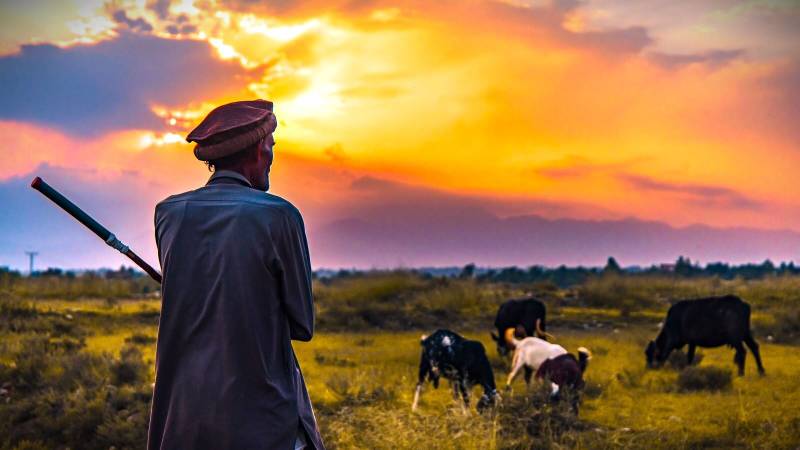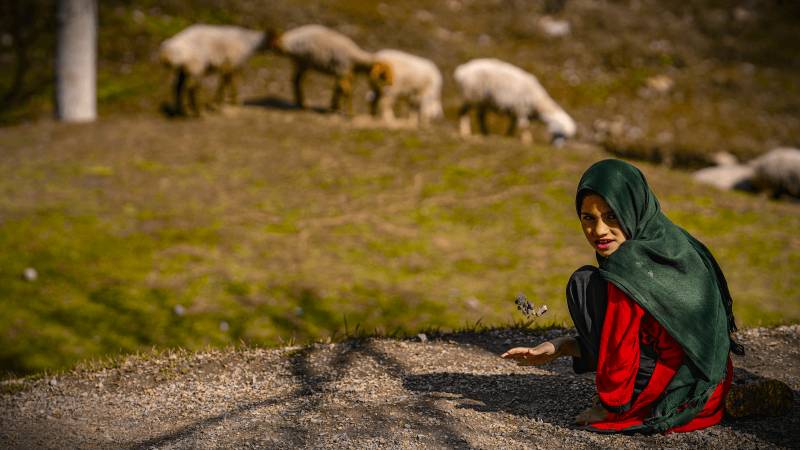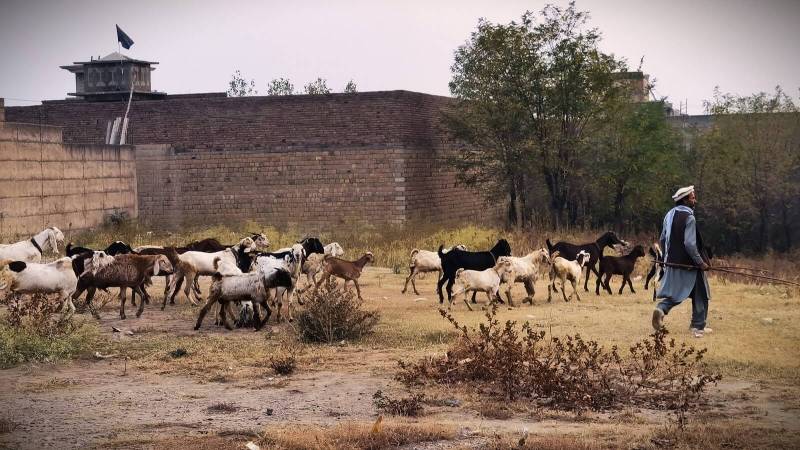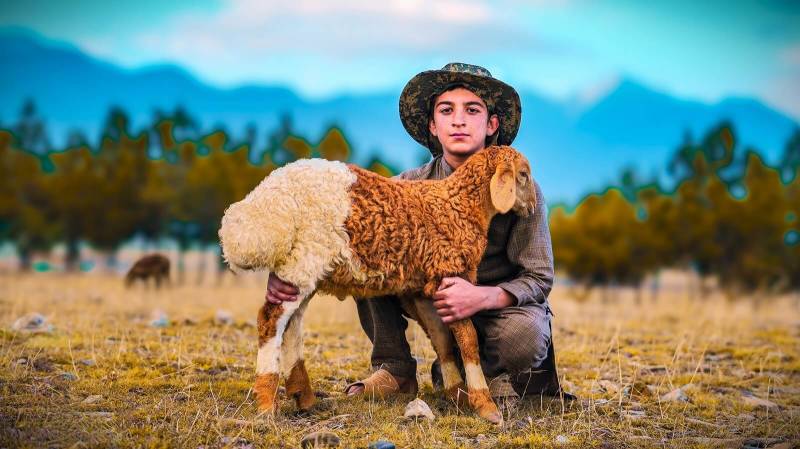
When Sundus, a resident of the remote Gujjar Gabral valley in the Bahrain area of Upper Swat, left her home in 2019 after being married, she did not know whether she would ever return to the scenic valley, be able to practice her traditional culture or speak her language widely.
Every year, government officials estimate that over 100,000 people migrate from Upper Swat to other parts of the country for various reasons. Local non-governmental organisations (NGOs) and researchers estimate that this number could be far higher and that hundreds of thousands of people undertake this journey annually.
This seasonal migration, driven by the harsh weather conditions and economic frailties, has become a way of life for many in Upper Swat. However, it also raises concerns about the long-term impact on the region, with researchers noting that the exodus has had an impact on the region's culture and language.
Migrating from Upper Swat
Sundus' journey out of the lush green, hilly valleys of Swat to the plains of Sialkot did not begin with her marriage in 2019; it began years earlier, in 2015, when she and her family first migrated out of the region.
Recalling the event, Sundus said she was just 14 years old at the time. As the wind turned chilly and the leaves started to change colour, Sundus said her family, including her parents, two sisters, and brother, packed their belongings and embarked on the 26-hour journey to Sialkot in Punjab aboard a truck. Leaving the valley on September 2, 2015, Sundus said her family hoped to escape the harsh winter and the financial difficulties that come with it.
Sundus said the journey from Gujjar Gabral to Sialkot typically takes 12 hours by car, but riding in the back of a truck took them over twice as long.
Upon their arrival in Sialkot, the six-member family moved into a small two-room house, which her father had arranged for them in advance at a rent of Rs2,500 per month.
The migration, Sundus said, was quite challenging because they had uprooted their lives to move into unfamiliar surroundings without relatives or friends.
"I never attended school, but I did receive religious education from a local woman named Kulsum in our village," said Sundus, suggesting that amalgamation in her new surroundings was difficult.
However, what complicated matters for Sundus was that her parents started to look for suitors for her. Underaged or not.
"My parents decided to marry me off in Sialkot, but the proposal fell through due to the high dowry demands in our Pashtun culture," she said, adding that her father's friends in Sialkot suggested potential suitors, but a match was not agreed upon because they were unemployed.

"In March 2019, my parents finalised my marriage to a man from Sialkot, and the engagement was set for August 2019," Sundus said, noting that ultimately, her fate was tied to Sialkot.
"My parents struggled financially, but they managed to make arrangements for the wedding."
Sundus said she was married later the same year.
But like when she first moved to Sialkot in 2015, Sundus recalled the difficulty in adjusting to a new environment in her husband's home.
"After marriage, I faced language barriers, cultural differences, and domestic violence," she recalled, adding, "My husband's family blamed me for being uneducated and sick, and they planned to throw me out."
When she became pregnant in July 2020, it did not stop the abuse.
"One day, I visited my neighbours, and they noticed my distress. Unbeknownst to me, they contacted my parents, who arrived in September 2020. My father and brother were shocked by my condition and spoke to my husband," Sundus said, adding, "After a lengthy conversation, my parents decided to take me back home."
Her husband made multiple attempts to patch things up with Sundus and her family, but her parents refused.
"In December 2020, my husband divorced me over the phone. Now, I live with my parents and my three-year-old daughter."
Though still quite young, Sundus says she is not too keen on getting remarried.
"I fear remarriage due to the cultural differences and language barriers I experienced," she said, expressing the belief that 90% of marriages between people from different regions and cultural backgrounds fail due to similar challenges which she faced.
"My advice is to avoid marrying off your children during relocation due to these challenges."
Leaving Upper Swat for winter
While Sundus' story may not be heard from every household in Upper Swat, what is heard in nearly every home in the region is families migrating to the plain areas for the winter and returning in the summer. However, in recent years, some of these migrations have become permanent.
Data gathered by the Swat Deputy Commissioner's office said that over 100,000 people migrate from Upper Swat every year.
The indigenous Torwali community has been disproportionately affected, with approximately 40% of the community having permanently migrated out of the region. In contrast, the Gujjar and Gawri communities migrate only seasonally, with around 70% leaving for the winter and returning in the summer.
Local NGOs estimate that between 52,000 to 53,000 members of the Torwali community have left their ancestral lands in the valley, compared to 30,000 to 32,000 from the Gujjar community, and 40,000 to 42,000 from the Gawri community in Upper Swat.
Migration, though, is not something that the people of Upper Swat are not unfamiliar with.
Zubair Torwali, a researcher who has spent over 15 years studying the region's languages, shared: "In Upper Swat, the Torwali, Gujjar, and Gawri communities migrate seasonally."
Zubair's research highlights the complexities of seasonal migration in Upper Swat, where communities navigate the delicate balance between economic necessity and cultural preservation.
He noted that seasonal migration is still a feature for residents of Upper Swat. These migrants travel to the plain areas of Pakistan and other, economically more prosperous regions, including Charsadda, Mardan, Nowshera, Peshawar, Rawalpindi, Gujarat, Faisalabad, Narowal, Gujranwala, Lahore, Karachi, and Quetta.
The impact of these migrations, however, is not fully reflected in the national census owing to the population growth rate in these areas. Located in Khyber Pakhtunkhwa, Swat spans some 5,337 square kilometres and has a population of 2,31 million people. The population comprises 50.8% males and 49.2% females. Over the last 19 years, the area has witnessed an impressive 84% growth in population.
The Bahrain Tehsil, one of the seven tehsils of Swat, has a population of just 270,620. Of these, 76,725 people live in urban areas, while the remaining 193,895 live in the rural parts of the tehsil.
The migration of Torwalis
Zubair explained to The Friday Times: "The Torwali people have migrated more permanently, with around 40% having relocated entirely."
The migrating Torwali community, he said, has settled in various parts of the country, including in the urban centres of Karachi, Quetta, Hyderabad, Sialkot, Lahore, Peshawar, Rawalpindi, and Nowshera.
While some members of the Torwali clan migrate due to seasonal changes, he said that many others did so for economic reasons.
Zubair Torwali added that the Gujjar community, which resides in areas like Pashmal, Lai Kot, Gujjar Gabral, Budi Seri, Mahodand, and Ushu, largely undertake annual season migration with around 70% of its population relocating. Similarly, the Gawri people from Ushu, Mattaltan, Mahodand, and Kalam also migrate.
A timeless tradition
Swat-based senior journalist Fazal Khaliq told The Friday Times that for centuries, the scenic valleys of Swat, Dir, Shangla, Chitral, and other areas in the Hindukush region have witnessed seasonal migration of residents with cattle herders taking their flock to the plains in the winter.
This tradition, Khaliq said, continues to date, and every year, thousands of people migrate with their goats and sheep to the warmer regions of Khyber Pakhtunkhwa, Punjab, and Sindh, where they earn a living by selling their livestock or taking up part-time jobs.
This ancient practice is deeply ingrained in the region's people and their culture, he said. Herders spend three to four months in Upper Swat during the summer, tending to their animals and enjoying the lush green pastures. But as winter sets in, they embark on a perilous journey to the plains, seeking refuge from harsh weather conditions that render their homeland uninhabitable.
Khaliq said that people from Kalam, Ushu, Mattaltan, Gujjar Gabral, Mahodand, and other areas join this exodus, fleeing heavy snowfall that often climbs to four to five feet, making life extremely challenging.
They find temporary solace in the plains, engaging in various occupations to earn a living.
Sultan Muhammad, a seasoned herder from Gujjar Gabral, shared his story with The Friday Times as he led his flock down from the hills to the plains of Punjab and Sindh to escape the harsh winter.

"This migration isn't just my story; it's our family's legacy," he said, adding, "My parents did it, and now I continue the tradition."
As we walked side by side, Sultan Muhammad pointed to his 80 sheep, two cows, and loyal dog. "We'll head to Charsadda first, then move to Punjab's regions, following the seasons and weather patterns."
While Sultan Muhammad's two sons accompanied us close behind, his three daughters and wife remained in Gujjar Gabral, awaiting his call to join them in Punjab after two months.
"This isn't an easy life," Sultan Muhammad admitted. "Few can endure the challenges of climate change."
He recalled how three years ago, he lost 40 sheep to a sudden storm in Bashigram. The financial loss was devastating – worth several hundred thousand rupees.
"No one helped us. We're a forgotten community."
For Sultan Muhammad, his animals are more than just livestock; they're a part of his family. "These sheep are like our children. We can recognise each one, even among thousands."
Impacting language
The thousands of people from different tribes of Swat, Upper Dir, Chitral, and Shangla, who migrate every year, leave behind a cultural vacuum. This large-scale migration has led to a loss of traditional customs, cultural values, and linguistic heritage. Migrant communities face an identity crisis, struggling to maintain their cultural roots amidst overwhelming external influences. Their language and culture are under threat, and urgent measures are needed to preserve their rich cultural heritage.
"The younger generation is shifting from their native languages to Pashto, Urdu, or Punjabi," Zubair noted, adding that seasonal and permanent migration significantly impacts the region's language and culture.
"Some understand their ancestral language but struggle to speak it fluently due to the changed environment."
A report from the Pakistan Bureau of Statistics on mother languages in the country, the most widely spoken mother tongue is Punjabi, with a staggering 89 million speakers, accounting for 38.4% of the population.
Pashto follows closely behind with 43.6 million speakers (18.5% of the population). Sindhi is spoken by 34.4 million individuals (14.5% of the population) while other prominent mother tongues include Saraiki (28.8 million), Urdu (22.2 million), and Balochi (8.1 million).
The report noted that Pakistan has a rich linguistic heritage, boasting an impressive array of mother tongues which are diversified with the likes of Hindko (5.9 million), Brahui (2.78 million), Kohistani (1.039 million), and Kashmiri (0.274 million). Smaller communities speak Shina (0.116 million), Balti (52,134), and Khowar (7,466).
Interestingly, the report notes that 3.37 million Pakistanis speak other languages as their mother tongues, highlighting the country's incredible linguistic diversity. This rich tapestry of languages underscores Pakistan's cultural wealth and the importance of preserving and promoting its linguistic heritage.
When asked about his language and culture, the shepherd from Gujjar Gabral shrugged. "We speak Gujjri, Punjabi and Urdu to communicate with people, and wherever we settle, we learn the local language."
Looking over his sons, we discussed the generation of Gujjar Gabral. Sultan Muhammad's expression turned resolute. "Our children won't become officers; they must learn this trade. Education isn't essential for them; this work is."

His words echoed the harsh realities of a traditional lifestyle, where survival depends on the land, seasons, and animals.
Sultan Muhammad's story represents the story of countless shepherds navigating Pakistan's rugged terrain, braving unpredictable weather, and clinging to their ancestral traditions. Their resilience is a testament to the enduring spirit of a nomadic people, bound to the land and their animals, as they continue their seasonal migrations, perpetuating a timeless legacy.
Other impacts of migration
Zubair, however, asserted that beyond the impact on language and culture, migration offers benefits to those migrating, such as access to better education and job opportunities in other, more developed provinces. Many such migrants have also achieved success in their adopted cities, he told The Friday Times.
As an example, he pointed to the Gawri community, which migrates extensively, with 70%-80% of its population temporarily relocating annually to cities like Takht-e-Bahai, Mardan, Charsadda, Peshawar, Rawalpindi, and other parts of Punjab.
Doing so, he said, affects the education of their children.
According to Zubair, some 52,000 to 53,000 Torwalis, 40,000 to 42,000 Gawris, and 30,000 Gujjars have migrated permanently from their ancestral lands.
He further said that migration has negative consequences for their women.
"Their health is neglected during travel, and they face numerous challenges in unfamiliar environments," Torwali said.
"Their education suffers, and poverty often leads to early marriages."
Challenges arising from migration
As migrants from these mountain communities settle - permanently in some cases - in their temporary homes, they face numerous challenges, from adapting to new environments to preserving their cultural heritage and to other modern issues. Meanwhile, their ancestral lands remain deserted, awaiting their return with the arrival of summer.
One issue, as the story of Sundus illustrates, marriages between migrant communities and locals often fail due to cultural differences, language barriers, and difficulties in maintaining healthy relationships. The cultural gap between the two communities threatens to engulf the traditional customs of the Pashtun or Malakand Division.
Khaliq told The Friday Times that history shows how people from those language communities with few speakers are more susceptible to linguistic assimilation. As migrant communities adapt to the languages of their adopted homes, their native languages and traditions begin to fade, threatening the loss of identity for migrant communities.
The consequences of this assimilation are far-reaching.
Lawyer and EVAW/G Focal Person Samreen Hakim told The Friday Times that even though migration - seasonal and permanent - is a common phenomenon in the region, it still creates its own set of legal issues for the people.
When people migrate, Hakim said, their property and homes remain unaffected in their village. However, upon return, they often find family members occupying their property.
"We get cases like these," Hakim said.
Since many migrants move across state lines, Hakim said that they can get caught in the variations in laws across Punjab, Sindh, Khyber Pakhtunkhwa, and Balochistan. For instance, the Malakand Division is a tax-free zone, whereas in Punjab, Sindh, and Balochistan, they must pay taxes.
Migration can also have other consequences for women, she said, noting that the tradition of purdah prevalent in Khyber Pakhtunkhwa is not as strictly followed in places like Punjab and Sindh. Moreover, women can face health and security concerns. Specially-abled individuals are particularly vulnerable during migration and can face various issues and potential violations of their legal rights.
Hakim, who is an advocate authorised to practice in the provincial high court, noted that the most significant challenge arises when migrants must attend court cases in other provinces such as Punjab, Sindh, or Balochistan, as their residential status and future are tied to these cases.

Regarding women, specifically child marriages, Hakim stated that the minimum age for marriage in Sindh is 18 while it is 16 in Punjab and Khyber Pakhtunkhwa.
Advocate Sohail Sultan, who is an elected member of the National Assembly from NA-4, Upper Swat, told The Friday Times that the annual migrations - which also take place across the international border from Afghanistan to Pakistan - positively impact the economy as migrants support one another across regions.
He emphasised the difficulties livestock migrants face, braving extreme weather conditions and long journeys. This migration affects their culture and language, potentially leading to a loss of cultural identity.
He added that participating in elections or getting counted in the census can prove challenging for migrants since these activities often coincide with their migration habits. He said that in Upper Swat, many cannot cast votes due to their seasonal migration while those financially stable with political ties are more likely to vote.
Listing the various communities that migrate seasonally, Sohail argued that the percentage of people who used to undertake the annual activity has reduced from over 50% to 20%.
Tackling Upper Swat's migration challenges
Swat Deputy Commissioner Shahzad Mahboob, whose office recorded data about annual migrations, told The Friday Times about migration patterns in Upper Swat.
"For centuries, people have been migrating from higher regions during winter and returning in summer," he said. "According to our records, over 100,000 people migrate annually due to harsh weather conditions and heavy snowfall."
He said the district administration, in collaboration with international organisations, provides over 500 winter survival kits to families living at higher altitudes. These kits include essential items to help them cope with the cold.
This year, Mahboob said, the administration aims to provide small business opportunities to those who choose to stay behind up the mountain with support from an international organisation.
Mahboob assured us that the district administration fully supports seasonal migrants by providing them security and traffic assistance during their journey. If their homes are damaged due to floods or other disasters upon return, local committees offer financial aid to rebuild them.
Mahboob said the district administration had introduced a road maintenance project to address connectivity issues in remote areas during snowfall, which will ensure that the roads remain accessible throughout winter.
Mahboob said that apart from being a traditional and historical feature, migration contributes to the national economy as migrants engage in small commerce like selling dairy products and animal hides or even as manual labourers.
However, Mahboob acknowledged that permanent migration affects local languages, culture, and traditions. "Most migrants settle permanently, adopt local customs, and marry into new communities, leading to the loss of their ancestral heritage," he said, adding. "We will take concrete steps to preserve their cultural identity."
Meanwhile, Zubair said his efforts to promote his native language have yielded some positive results.
"Now, people are speaking their local language at home, thanks to our campaign," he said.
The migration cycle has been repeating for generations, with no signs of slowing down. The question remains: what does the future hold for these migrant communities, and how will their movements shape the region's destiny?
As the seasons change, shepherds return to their lands, bringing home stories of their experiences in the plains, the allure of the plains remains strong, drawing them back year after year. This timeless cycle of migration continues, testifying to the resilience and adaptability of the people of the Hindu Kush region.

